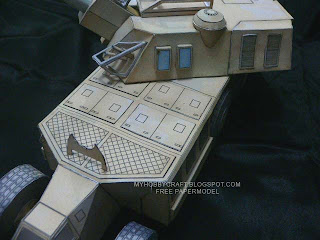The G6 Rhino is fitted with a 155-mm gun-howitzer, developed from the G5 towed gun-howitzer and additionally fitted with semi-automatic loading system and fume extractor. The G6 Rhino fires HE-FRAG, smoke, illumination and incendiary rounds. It is compatible with all NATO 155-mm ammunition. A total of 47 rounds are carried. Maximum range of fire is 30 km with standard HE-FRAG projectile and 39 km with rocket-assisted. It also fires newly developed velocity enhanced long range projectiles with a maximum range of 50 km.
The G6 Rhino can fire the first round within 60 seconds. Out of action time is 30 seconds, which allows to avoid counter-battery fire and gives shoot-and-scoot capability.
Secondary armament consists of 12.7-mm machine gun, mounted on top of the roof. There are also a number of smoke grenade dischargers.
The G6 Rhino has a welded hull and turret. It's front arc provides protection against 20-mm rounds. All-round protection is against small arms fire and artillery shell splinters. This vehicle is well protected against landmines. This artillery system is fitted with an automatic fire suppression system. An NBC protection system can also be fitted, if required. Some firing ports are provided for the crew.
Vehicle has a crew of five, including commander, gunner, two loaders and driver.
Unlike many other self-propelled artillery systems the G6 Rhino is based on wheeled 6x6 chassis. It is powered by a diesel engine, developing 525 hp. It is also fitted with auxiliary power unit, which powers all system when the engine is turned off.
www.military-today.com




price :US $4
buy now here
please give some note the model name in paypal transaction and choose "send as give/friends" option
for Indonesian you can have it here








































































